Intel DC P3520 Enterprise SSD Review
Why you can trust Tom's Hardware
QoS, Teardown And Architecture
Teardown
Architecture
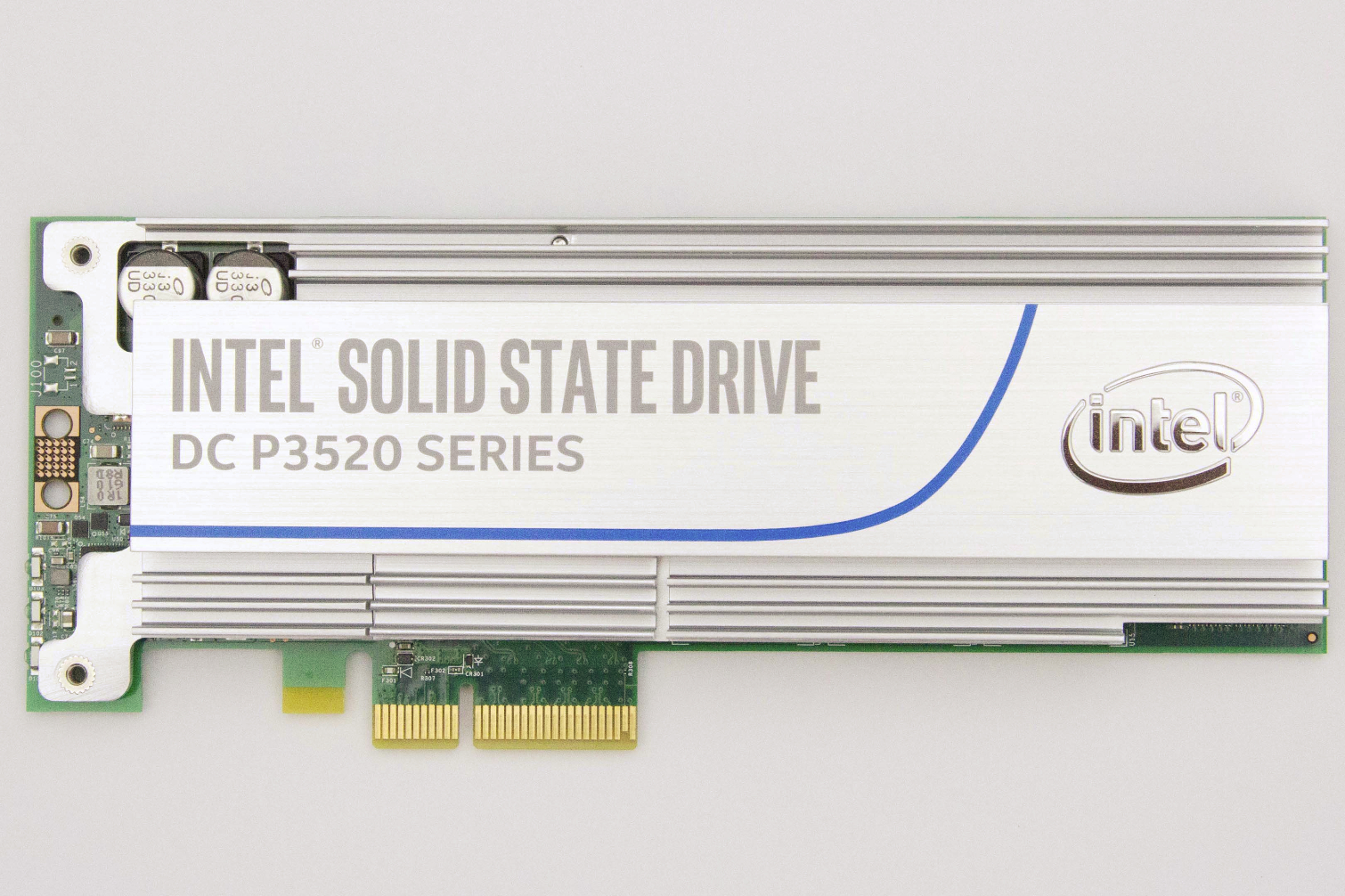
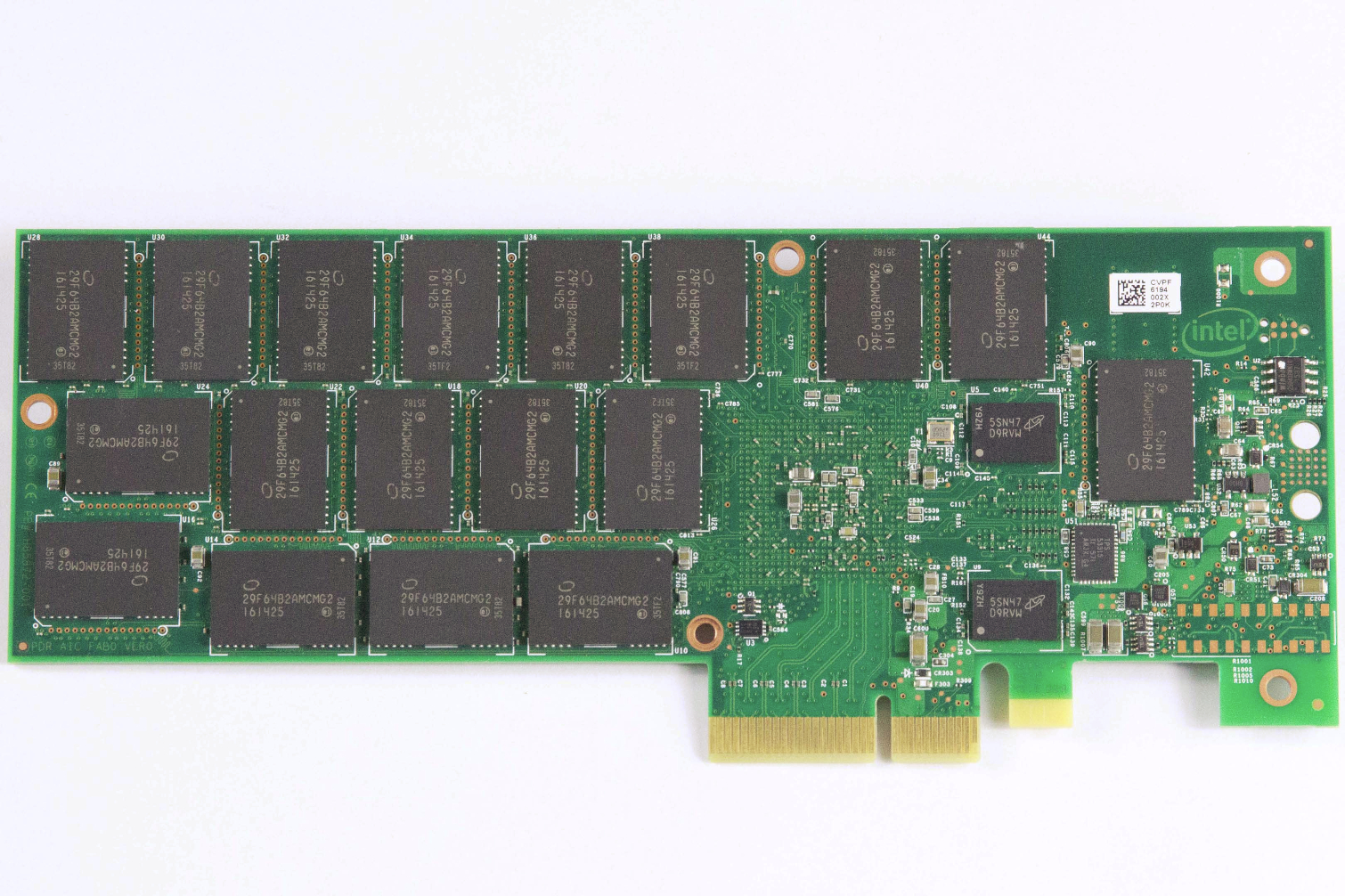

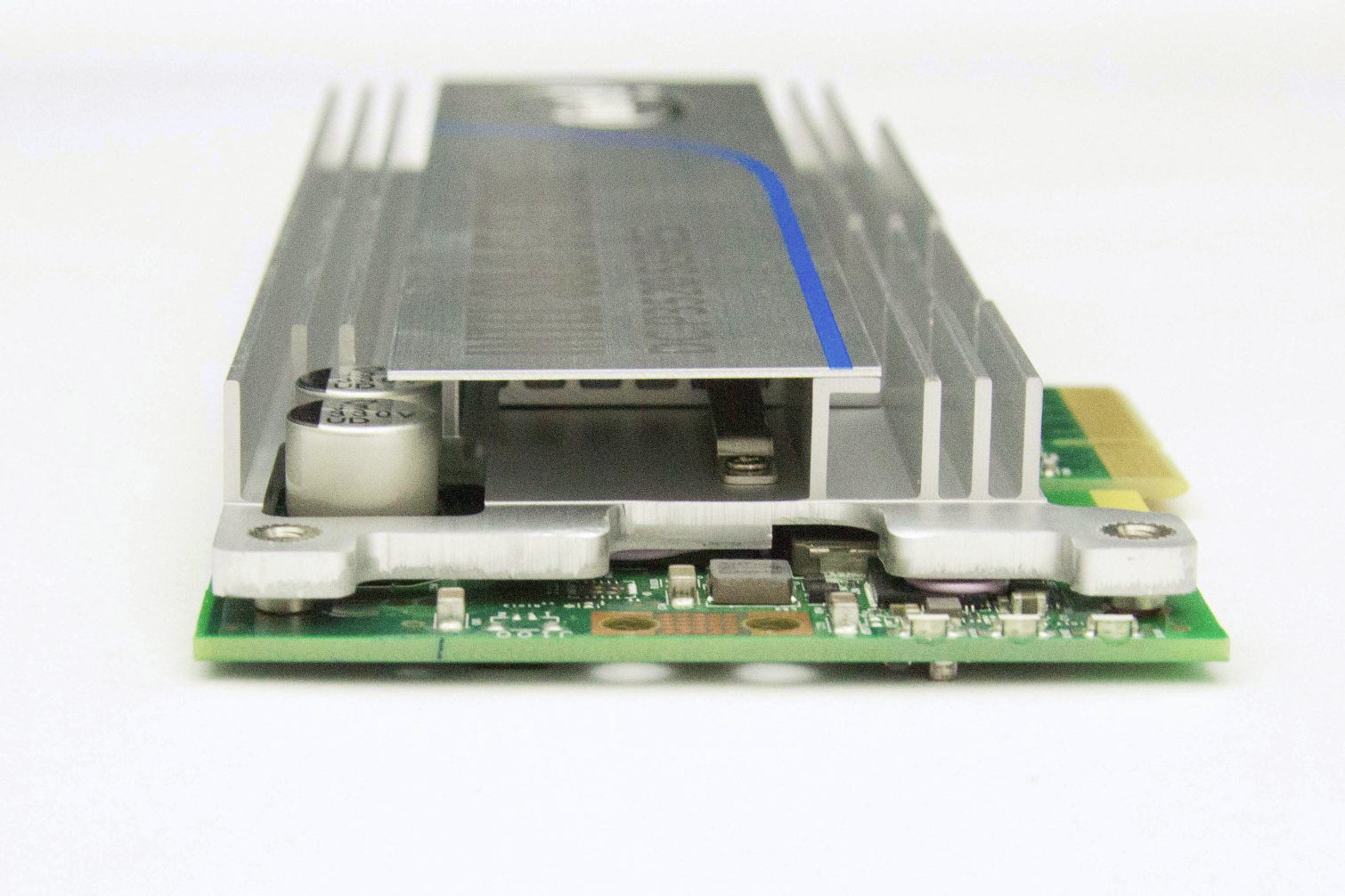
The Intel DC P3520 features the standard AIC form factor (above), though 2.5" options are also available. The AIC model requires up to 300LFM of airflow to stay cool, while the 2.5" model requires up to 650LFM. The heatsink consists of a large shroud that covers the face of the device. There is also a smaller dedicated internal heatsink for the proprietary Intel 18-channel controller, and we can see the smaller internal fins poking through when we peer down the internal air channel. Two large capacitors poke up into a hole in the heatsink. The capacitor provides enough power to flush all data in transit to the NAND in the event of a host power loss event.
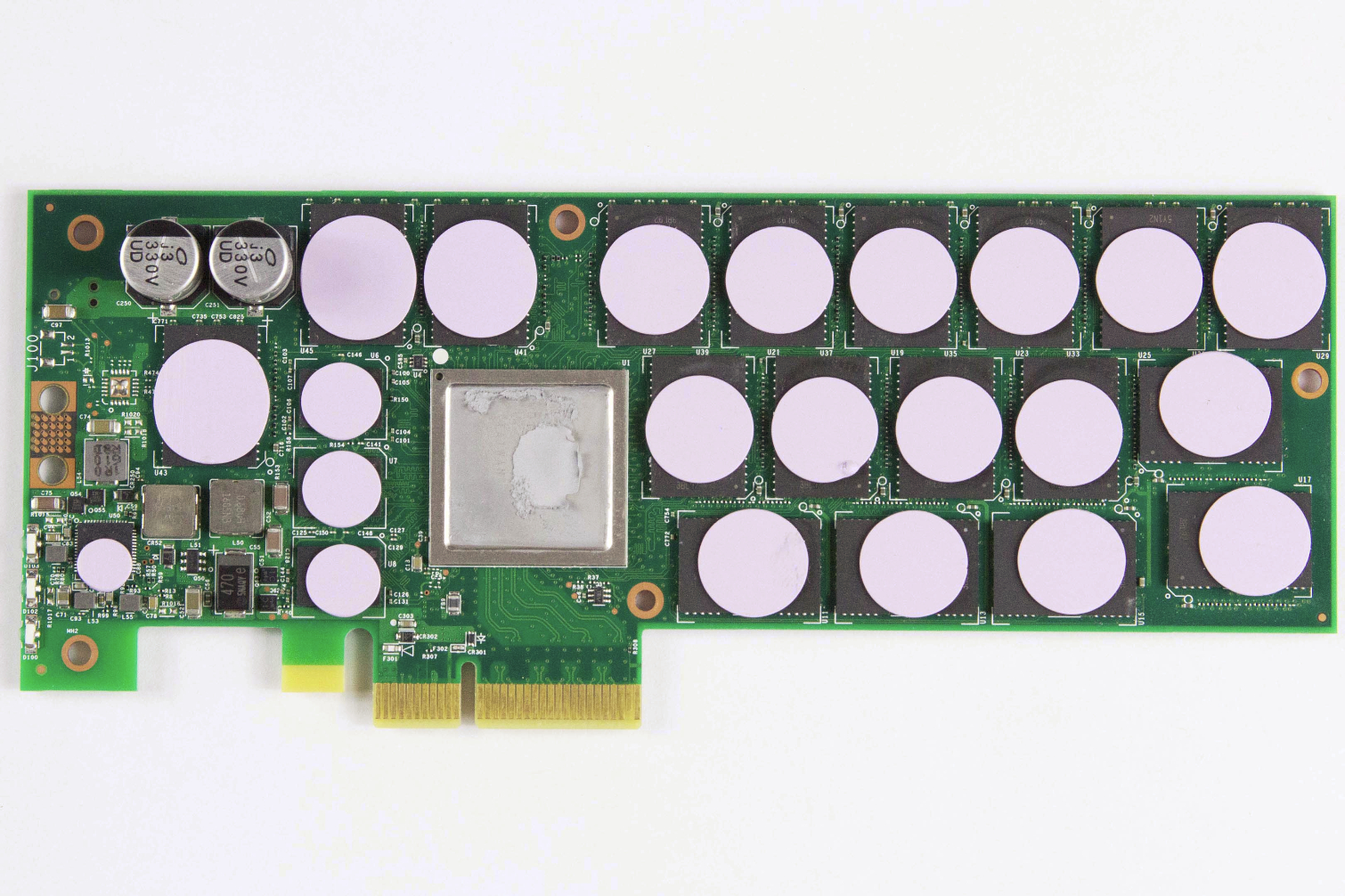

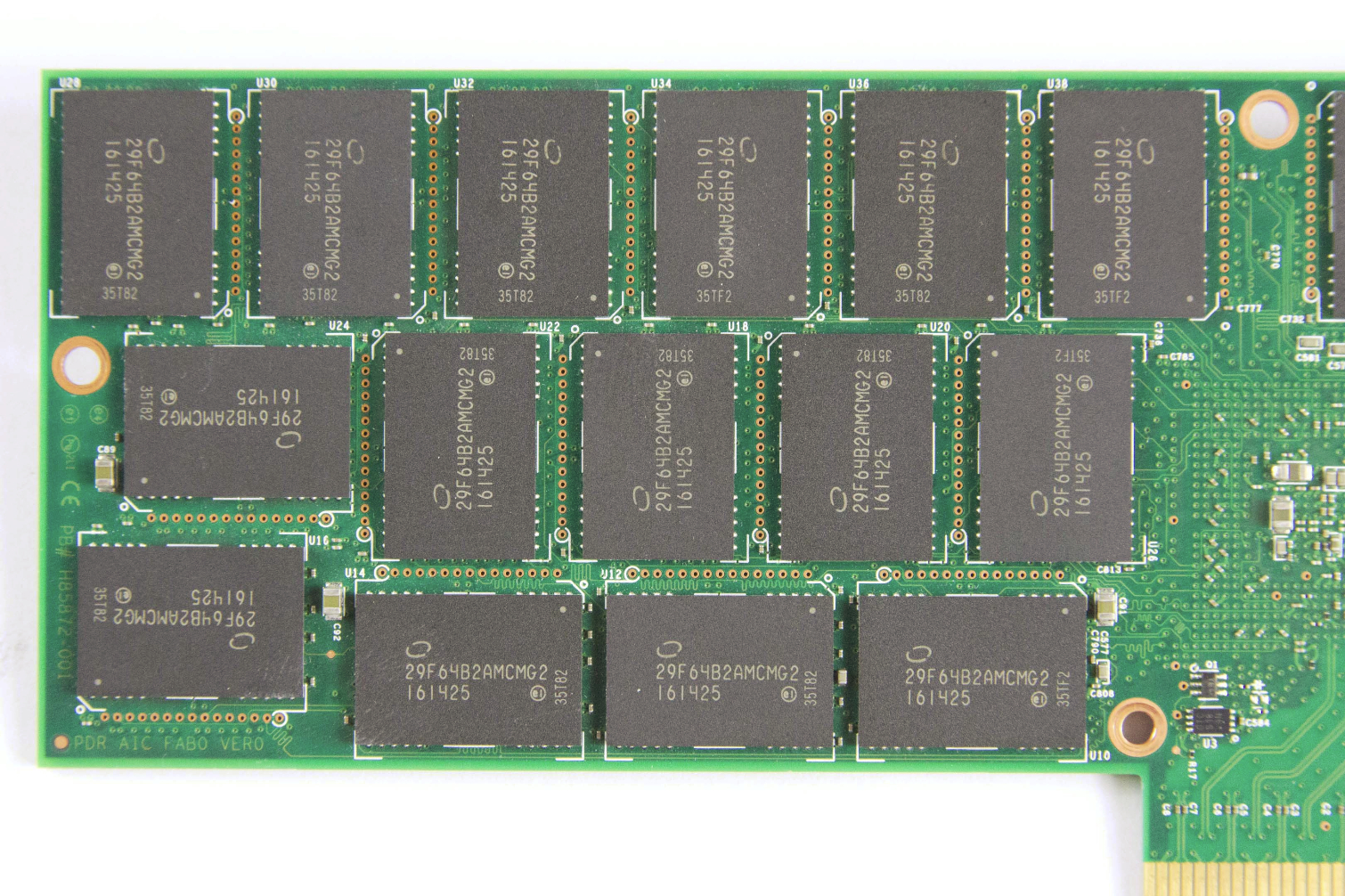
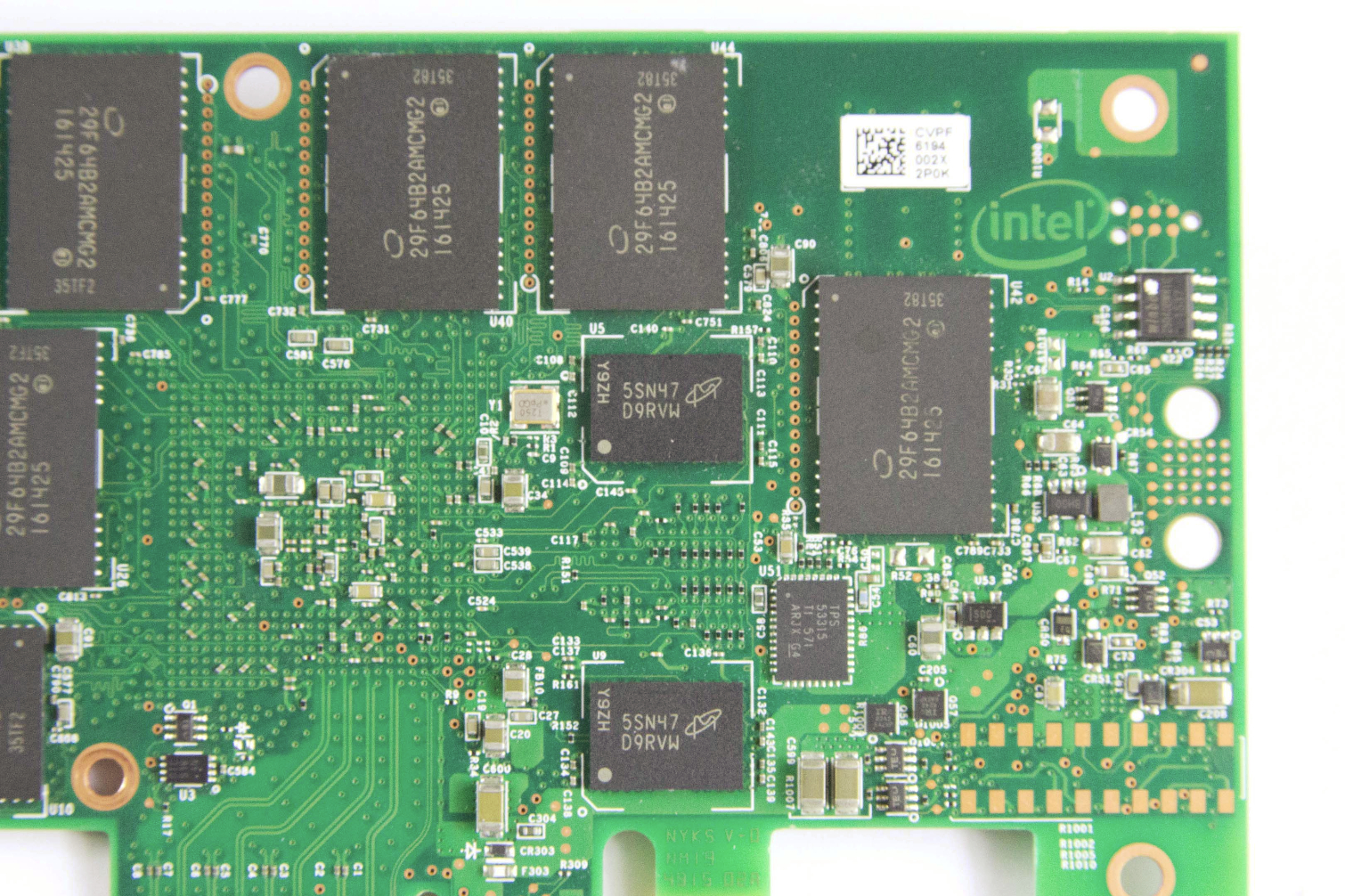
Intel spread 36 NAND packages out on both sides of the PCB, and there are likely two MLC die per package, which indicates a raw NAND capacity of 2,304GB. At times, Intel will use packages of varying densities to reach various capacity points, so the raw capacity is an unconfirmed measurement. Intel's P Series platform uses LDPC error correction, which is much more powerful than standard BCH ECC and is an important facet of the company's endurance management scheme.
Intel lost some performance due to the reduced die count, so staying with the same number of packages is necesary to minimize the impact. Intel could maintain the same capacity as its previous products with fewer packages by including more of the denser 3D NAND die per package, but this would result in even less parallelism to fuel the controller. IMFT 3D MLC employs a quad-plane design, which means that there are four areas of each die that respond independently to data requests. The quad-plane design increases per-die performance compared to the previous-generation dual-plane planar die.
Thermal pads help to cool the heat-generating components by wicking heat into the heatsink. The design also features five Micron DDR3-1866 DRAM packages, which equates to 2.5GB in an ECC arrangement.
The DC P3520 has all of the features we’ve come to expect from class-leading enterprise SSDs, such as end-to-end data path protection (T10 DIF), a 1 per 10^17 UBER measurement, 2 million hour MTBF, power loss protection (self-test as well), out-of-band management support, AES 256-bit encryption, and advanced thermal throttling. The 2.5” models also support hot plugging.
QoS Specifications
| All values in ms | QD | P3520 2TB (Spec) | P3520 2TB (Our Results) | P3500 2TB | DC P3700 2TB | P3520 450GB | P3520 1.2TB |
|---|---|---|---|---|---|---|---|
| 99% Random Read | 1 | 0.16 | 0.139 | 0.120 | 0.12 | 0.1 | 0.2 |
| 99% Random Read | 128 | 1.1 | 1.352 | 0.75 | 0.750 | 3.5 | 1.4 |
| 99% Random Write | 1 | 0.15 | 0.135 | 0.1 | 0.09 | 0.5 | 0.1 |
| 99% Random Write | 128 | 13 | 12.48 | 18 | 6 | 18 | 13.1 |
| 99.99% Random Read | 1 | 1.8 | 0.201 | 4 | 4 | 0.8 | 0.3 |
| 99.99% Random Read | 128 | 3.0 | 3.28 | 5 | 5 | 6.3 | 3 |
| 99.99% Random Write | 1 | 0.7 | 0.628 | 4 | 0.250 | 4.3 | 0.8 |
| 99.99% Random Write | 128 | 25 | 24.192 | 30 | 15 | 41.2 | 28.3 |
Intel has an intense focus on performance consistency; it was even the first SSD vendor to publish dedicated Quality of Service (QoS) specifications, although others followed. We tested the DC P3520 in CentOS 7 with the 4.7 kernel, which might contribute to some variation from Intel's Windows-derived specifications. Our measurements surpassed Intel's specifications in most workloads, though we did record higher random read 99th and 99.99th percentile measurements.
The DC P3520 has relaxed QoS specifications compared to the previous-generation DC P3500 for the 99th percentile results, but better performance with the more demanding 99.99th percentile specifications. The DC P3700 continues to offer the best QoS measurements, but its refined performance comes with a higher price. Most read-centric workloads do not require such a tight QoS envelope, so the trade off of reduced cost and QoS performance makes sense for mainstream applications.
Get Tom's Hardware's best news and in-depth reviews, straight to your inbox.
MORE: How We Test Enterprise SSDs
MORE: How We Test Enterprise HDDs
Current page: QoS, Teardown And Architecture
Prev Page Intel Rolls Its 3D MLC NAND Into The Data Center Next Page Endurance Matters And Management
Paul Alcorn is the Editor-in-Chief for Tom's Hardware US. He also writes news and reviews on CPUs, storage, and enterprise hardware.
-
Game256 Paul, Chris, any updates regarding possible release dates of Samsung 960 EVO/PRO? Have you received the samples already?Reply -
DocBones Glad to see more u.2 formats, really dont like m.2 for desktops. That 2mm screw is a pain.Reply -
Tom Griffin Am I am idiot but should this be on Tom's IT Pro? Aside from that the M.2 for an enterprise drive simply does not jive on current motherboards look at PCIe lane allocation. 4x lanes one drive even the high end CPUs with 40 lanes will choke with more than 4.Reply -
bit_user Reply
You might be right, but I'm glad it's not. It represents superb read-oriented SSD performance. Especially for the price.18682745 said:this be on Tom's IT Pro?
It's not M.2. They have PCIe add-in cards and U.2 form factors. M.2 wouldn't fly, due to the power dissipation, if not also the board area needed.18682745 said:Aside from that the M.2 for an enterprise drive
How many of these are you planning to use? This is for read-intensive workloads, so you'd hopefully just need one, which could be paired with cheaper storage for everything else. I guess at the high end, you might pack a machine full of them, but then you might have more than one CPU (which adds yet more PCIe lanes).18682745 said:simply does not jive on current motherboards look at PCIe lane allocation. 4x lanes one drive even the high end CPUs with 40 lanes will choke with more than 4.
BTW, did you know that M.2 is a popular form factor for high-end desktop SSDs? It supports up to 4-lanes. So, it would seem that some people think such performance is worth the resource footprint. -
bit_user ReplyThe P3520 actually takes a step back on the performance front in comparison to the previous-generation DC P3500, which featured up to 430,000/28,000 read/write IOPS.
Given the deals out there to be had, the real star of the show is the DC P3500. If you can live with the lower endurance than the P3520, it offers a compelling alternative to the 750-series. Here's how they compare:
http://ark.intel.com/compare/86740,82846
Update: snagged a 400 GB DC S3500 at $225. Price is now back up to $275. Worth keeping an eye on, if you're interested. Supposedly, a full-height bracket is included in the box. I'll update again, to confirm. -
bit_user I'm just interested in the read performance, but I noticed two pairs of images that are nearly identical. I loaded them in different tabs and flipped back and forth. The only difference seems to be whether the lines from different queue depths are connected.Reply
http://media.bestofmicro.com/ext/aHR0cDovL21lZGlhLmJlc3RvZm1pY3JvLmNvbS9leHQvYUhSMGNEb3ZMMjFsWkdsaExtSmxjM1J2Wm0xcFkzSnZMbU52YlM5R0x6WXZOakV3T1RZeUwyOXlhV2RwYm1Gc0x6QXpMbkJ1Wnc9PS9yXzYwMHg0NTAucG5n/rc_400x300.png
http://media.bestofmicro.com/ext/aHR0cDovL21lZGlhLmJlc3RvZm1pY3JvLmNvbS9leHQvYUhSMGNEb3ZMMjFsWkdsaExtSmxjM1J2Wm0xcFkzSnZMbU52YlM5R0x6a3ZOakV3T1RZMUwyOXlhV2RwYm1Gc0x6QTBMbkJ1Wnc9PS9yXzYwMHg0NTAucG5n/rc_400x300.png
And:
http://media.bestofmicro.com/ext/aHR0cDovL21lZGlhLmJlc3RvZm1pY3JvLmNvbS9leHQvYUhSMGNEb3ZMMjFsWkdsaExtSmxjM1J2Wm0xcFkzSnZMbU52YlM5R0x6Y3ZOakV3T1RZekwyOXlhV2RwYm1Gc0x6QXhMbkJ1Wnc9PS9yXzYwMHg0NTAucG5n/rc_400x300.png
http://media.bestofmicro.com/ext/aHR0cDovL21lZGlhLmJlc3RvZm1pY3JvLmNvbS9leHQvYUhSMGNEb3ZMMjFsWkdsaExtSmxjM1J2Wm0xcFkzSnZMbU52YlM5R0x6Z3ZOakV3T1RZMEwyOXlhV2RwYm1Gc0x6QXlMbkJ1Wnc9PS9yXzYwMHg0NTAucG5n/rc_400x300.png
Not really a complaint - just an observation. As long as the data is accurate, no harm done.
Then, at the end of the read graphs, it seems like some AMD slides crept in? Oops?
BTW, the Latency vs. IOPS is now officially my second favorite SSD performance graph (after IOPS vs. queue depth, of course).